Abstract
The performance advantage of active rather than passive recovery during subsequent trials for repeated high intensity short-term exercise is well documented. Research findings suggest that shorter periods of active recovery, than traditionally employed, can be prescribed and still retain performance benefits over passive recoveries in successive exercise trials. The aim of this study was to examine the benefits of a short duration active recovery for repeat climbing trials. Ten recreational climbers volunteered for the study. In this randomly assigned crossover study each climber completed five two-minute climbing trails before a two minute active or passive recovery. This was followed by a one and a half minute passive refocusing period for all climbers before the subsequent climbing trial. Heart rate was monitored continuously, RPE immediately post climbing and fingertip capillary blood samples collected during each refocusing phase. There was a non-significant difference between active and passive recoveries for heart rate during climbing. After the active phase climbers had higher heart rates than when following the passive recovery protocol, however, by the end of the refocusing phase the active recovery protocol led to lower heart rates than for the entirely passive recovery. There was a significant difference between active and passive recovery conditions in lactate concentration (F(1,9) = 18.79, p = 0.002) and RPE (F(1,9) = 6.51, p = 0.031). Lactate concentration and RPE were lower across all five climbing trials for the active recovery protocol. After active recovery climbers started the next trial with a lower arterial lactate concentration than for a passive recovery and indicated lower RPE scores at the end of each climb. The refocusing period following active recovery allowed climbers heart rates to return to a lower level at the start of the next climb than for the passive recovery condition.
Key Points.
The three and half minute recovery strategy employed in this study did not allow sufficient time for complete recovery for either the active or passive conditions.
The active condition appeared to allow for a more complete recovery after each climbing trial than did the passive recovery.
Lactate concentrations and RPE were lower for the active recovery.
The use of larger and or alternative muscle groups in the active recovery may benefit lactate clearance.
The use of a refocusing passive phase at the end of the active recovery may provide a useful and more ecologically valid mechanism for recovery in an applied sporting context.
Key words: Rock climbing, RPE, lactate concentration, active recovery
Introduction
The identification of lactic acid as a product of muscle activity was discovered early in the 20th Century (Fletcher and Hopkins, 1907). Since this time the body of knowledge relating to the production and removal of lactate in relation to exercise has grown (Van Hall et al., 2002). It has been shown that short-term high intensity exercise produces high levels of arterial lactate with values of up to 25 mmol·1-1 being reported in highly motivated individuals (Mainwood and Renaud, 1985; McLoughlin et al., 1991; Rowell et al., 1986). Research tracing the fate of lactate has identified that a number of organs are involved in lactate removal (Connolly et al., 2003). During exercise producing high arterial lactate concentrations it has been found that both active and non-active skeletal muscles uptake lactate (Ahlborg et al., 1975; Carlson and Pernow, 1959; Freyschuss and Strandell, 1967). Research by Gollnick et al., 1981 revealed that in cycle ergometry, where one leg had reduced and the other normal glycogen stores, in the leg with higher stores the active muscles released lactate into the blood whereas those in the other leg consumed lactate. Further to this it has been shown that lactate uptake by skeletal muscle is increased when light exercise is performed in preference to complete rest (Hermansen and Stensvold, 1972; Richter et al., 1988). There appears to be a dynamic situation with regard to the exchange of lactate as a fuel source across muscle fibres within an exercising muscle and between working and non-working muscle groups.
Glycolytic metabolism and the effects of lactate on performance have now been studied in relation to active and passive recovery for over thirty years (Belcastro and Bonen, 1975; Hermansen and Stensvold, 1972; Weltman et al., 1977). Research has predominately employed a single high intensity short duration exercise bout capable of producing high levels of lactate. In early studies relatively long duration recoveries were utilised to achieve significantly lower lactate levels. Hermansen and Stensvold (1972) and Belcastro and Bonen, 1975, for example, employed periods of 30 minutes treadmill running at 60-70% VO2max and recumbent cycling at 30-45% VO2max respectively.
Later studies by Ahmaidi et al. , 1996, Bogdanis et al., 1996 and Corder et al., 2000 have gone on to examine the effects of shorter duration active recovery between repeated bouts of cycling or parallel squats. These recovery periods, which were of four to five minutes duration, were not designed to reduce lactate levels to pre-exercise conditions, but to maintain performance levels across subsequent trials and to optimise lactate removal when compared with passive recovery. Ahmaidi et al., 1996 and Corder et al., 2000 found significant reductions in lactate during short duration low intensity active recoveries when compared with passive recovery involving three or more bouts. In addition, performance and rating of perceived exertion (RPE) appeared to improve in the low intensity recovery condition. Although research findings remain equivocal as to whether reductions in lactate lead to a resultant improvement in performance (Ainsworth et al., 1993; Bangsbo et al., 1994) it does appear that long periods of recovery such as those employed by Hermansen and Stensvold (1972) and Belcastro and Bonen, 1975 may not be required in situations of repeated exercise.
The sport of climbing has a great variety of disciplines with a wide range of exercise intensities placing different demands on the climber’s energy systems. Climbing bouldering problems, consisting of approximately one to four moves, will rely on ATP stores within the muscles and the replenishment of ATP through the ATP-PC system. For longer bouldering problems and short sport climbing routes of one to two-minutes duration - the climbing equivalent of short term high intensity exercise - glycolysis provides the main energy source. On mountain routes and in big wall climbing, where the relative intensity of climbing is lower the aerobic energy system becomes the major source for the demands of the activity. In a climbing context the employment of an active recovery strategy is most appropriate for bouldering and short (often pre-practised) sport climbing routes. Sport climbing involves the climber clipping their safety rope to pre-placed steel or aluminium anchors as they ascend the climb. In the discipline of bouldering climbers ascend smaller routes of up to approximately five metres in height without the use of ropes, but often with a safety mat placed below the climb.
The great variety of forms of climbing available and the increasing development of indoor climbing walls has led to a rise in the popularity of the sport worldwide (BMC, 2004). A growing body of research has accompanied this rise in climbing participation with the publication of studies describing anthropometric profiles, (Watts et al., 1993; Mermier et al., 2000) changes in hand grip strength and endurance (Watts et al., 1996) and energy expenditure in rock climbing (Mermier et al., 1997; Booth et al., 1999). The application of active and passive recovery in climbing has been studied and documented once by Watts et al., 2000. This novel research used fifteen expert climbers who led a single 20 metre route graded at 5.12b using the Yosemite Decimal Scale (YDS) set on an indoor climbing wall. On completion of the route subjects were lowered to the ground and completed a 30-minute recovery period. For the active recovery group blood lactate remained elevated above pre-climb level for 20 minutes, where as it took the full 30 minutes for the passive recovery group’s lactate concentrations to return to pre-climb levels. Watts et al., 2000 concluded that there was a need for further sport specific research into the effects of short duration active recovery during high intensity intermittent climbing trials.
In a study by Connolly et al., 2003 the researchers identified the need to bring study protocols in the area of active and passive recovery closer to strategies employed by sports performers in training and competition. Athletes would generally not wait up to 30 minutes before completing a further exercise trial. Further research employing shorter recovery periods is required to examine their appropriateness for use with athletes involved in short duration high intensity exercise. Consequently, the aim of this study was to examine the effects of a short-term active recovery on repeat performance in high intensity short duration climbing.
Methods
Participants
Ten male recreational climbers (age 22 ± 3.6 years; height 1.74 ± 0.06 m; mass 70.6 ± 5.3 kg; mean ± SD) from the University of Chichester volunteered to participate in this study. Ethical approval was obtained for the study and all climbers completed informed consent and a health history questionnaire. The participants were regular climbers for whom climbing was a main recreational activity, taking part in one or two indoor sessions per week on a regular basis.
Experimental overview
All participants completed both active and passive recovery conditions using a randomly assigned two-way crossover design. A minimum of seven days was given between each condition. Participants followed a ten minute warm-up which comprised of light jogging, stretching and low intensity bouldering. Personal rock boots and chalk bags were used throughout. The climbing protocol was identical for both conditions and consisted of five two minute climbing trials. In the passive recovery condition participants rested for two minutes after each climb. For the active recovery condition participants completed a two minute active recovery protocol. After this all participants undertook a further one and half minute passive recovery.
Sports performers do not move immediately from an active recovery to the next bout of exercise. They generally take time after stopping exercise to prepare for the next exercise bout. To maintain the ecological validity for a climbing context a refocusing period was included for both recovery protocols. The refocusing phase was designed to allow climbers to prepare themselves mentally for the next climbing trial, clean their boots and re-chalk their fingers. During this time arterial capillary blood samples (150 µl) were collected from the right index fingertip of each climber and analysed using a YSI 2300 Stat Plus (Yellow Springs Instruments, Ohio, USA). Blood lactate samples were taken post warm-up, post two minute recovery after each climbing phase and five minutes post climb five. Rating of Perceived Exertion was recorded immediately post climbing using the Borg scale (Borg, 1982) and heart rate was taken every five seconds throughout using a Polar PE3000 Heart Rate Monitor (Polar Electro Oy, Kempele, Finland).
Procedures: Climb
Participants were required to climb on an indoor wall up and down a specific route between clearly marked holds for duration of two minutes for five trials in each condition. A climbing duration was allocated as opposed to a single ascent to counteract any individual differences in any climber’s ability. This protocol was based on research by Hardy and Martindale, 1982 who found that expert climbers travelled further than beginner climbers in the same time period, while producing similar lactate levels.
As is shown in Figure 1 the wall was set at an angle beyond vertical (106o) to achieve an increased work load resulting in higher lactate levels as proposed by Watts and Drobish (1998). The starting and finishing holds are shown in Figure 2 and set at 4.1 metre displacement. For each trial climbers started using the bottom left holds. During the trial climbers followed a self-selected route to the top finishing hold and then down-climbed to the starting position, continuing this pattern until the end of the two minutes. The climb was designed such that which ever route was selected the grade was maintained at English technical 4C (YDS 5.8). Twenty centimetre Sutcliffe Leisure Safety mats were used throughout testing in case a climber fell. If a participant did fall, they were asked to step back on and continue until the two minute trial was completed.
Figure 1.
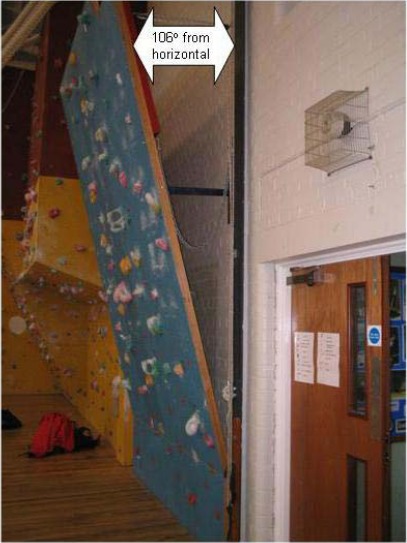
A climbing angle of 106° was calibrated to achieve the appropriate climb for a recreational climber. This also provided an angle exceeding vertical, which complied with the findings of Watts and Drobish (1998) that angles beyond vertical produce significantly higher lactate.
Figure 2.
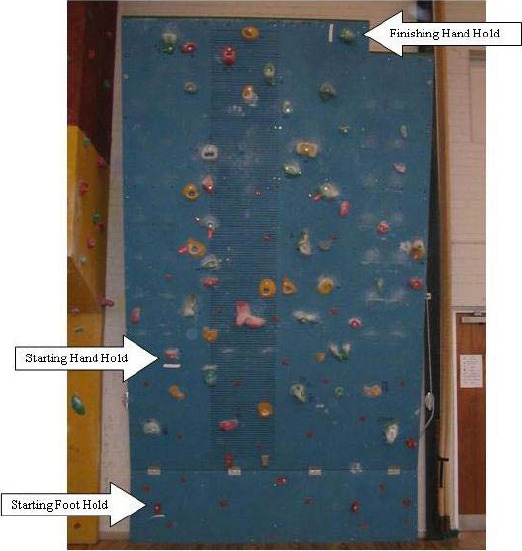
The route was climbed between the three-marked holds, which had to be touched before returning in the opposite direction. The climbing route used large bolt on holds for hands and small screw on holds for feet.
Recovery
The active recovery protocol was designed to incorporate an ecologically valid recovery method usable by climbers in the climbing environment. This required an alternative approach than the laboratory procedures of recumbent cycling used by Belcastro and Bonen, 1975, Connolly et al., 2003, Watts et al., 2000. A walking-based recovery strategy was employed for the purposes of this study. To accurately control the intensity of the two minutes of active recovery a modified version of level one of the sportscoachUK multistage fitness test with a reduced distance of 14 metres, as opposed to the original 20 metres, was developed (Leger and Lambert, 1982). This resulted in participants walking at a moderate to fast walking pace. During the two minutes active recovery each participant completed a distance of 182 metres. The passive recovery involved two minutes of resting in a seated position. Both active and passive recoveries were then followed by one and a half minutes of passive recovery to enable participants to refocus for the subsequent climbing trail. This time was also utilised to enable blood lactate sampling and for the sample pinprick to dry before a subsequent climbing trial, giving an overall recovery of three and a half minutes.
Statistical analysis
Descriptive data, means and standard deviations, were calculated for lactate concentration, RPE and heart rate data after being checked for normality using the Kolmogorov-Smirnov test. Two-way repeated measures ANOVA were then employed to analyse the lactate and RPE data - condition (active or passive recovery) by climbing trial. For the during climb heart rate data five paired samples t-tests were calculated to examine whether the work intensity, as measured by heart rate response, was significantly different for the active or passive recovery conditions. To analyse the recovery phase heart rate data the mean and standard deviation heart rate responses for active and passive recoveries were calculated across three points of the recovery. These points were the heart rate for climbers at the start of the recovery phase, at the end of the two minute passive/active recovery and lastly at the end of the one and a half minutes refocusing phase. From these results the scores from start of warm-up to end of active/passive recovery and start and end of recovery were computed. The scores were analysed using paired samples t-tests to check for significant differences between recovery strategies. An alpha level of p < 0.05 was set to assess statistical significance of results and the analyses were calculated using the SPSS 12.0.1 for Windows and Microsoft excel software packages.
Results
Results from the Kolmogorov-Smirnov test indicated that data for lactate concentration, RPE and heart rate displayed normality of distribution. The lactate concentration data for the two conditions, active and passive recoveries, are shown in Figure 3. The mean lactate concentrations were between 0.9 and 1.2 mmol·1-1 higher for passive recovery after each of the five climbing trials.
Figure 3.
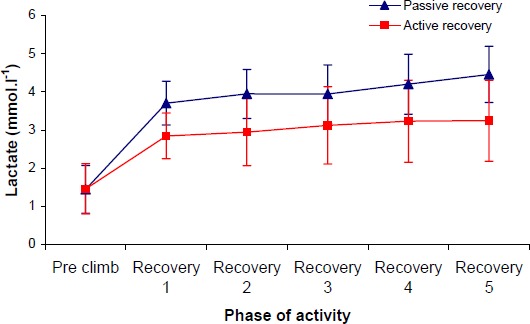
Capillary blood lactate concentrations for passive and active recoveries (mean ± SD).
There was a significant difference between active and passive recovery conditions (F(1,9) = 18.79, p = 0.002). As Figure 3 shows the mean lactate concentrations rose with successive climbing trials for both conditions (F(4,36) = 4.04, p = 0.038). Rating of perceived exertion scores are shown for the two conditions in Table 1. Participants reported between 0.6 and 1.0 higher RPE scores when utilising the passive recovery protocol.
Table 1.
RPE scores immediately post the five periods of climbing. Data are means (±SD).
| Post Climb 1 |
Post Climb 2 |
Post Climb 3 |
Post Climb 4 |
Post Climb 5 |
|
|---|---|---|---|---|---|
| Active Recovery | 12.3 (2.3) | 13.7 (2.0) | 15.2 (2.0) | 16.3 (1.8) | 17.3 (1.8) |
| Passive Recovery | 12.8 (1.6) | 14.3 (1.9) | 15.9 (1.9) | 17.3 (1.9) | 17.3 (1.8) |
A significant difference was found between conditions (F(1,9) = 6.51, p = 0.031). As Table 1 shows the mean RPE scores rose with successive climbing trials for both conditions (F(4,36) = 69.89, p < 0.0005).
Heart rates during climbing were recorded every five seconds throughout the climb duration. From this data the mean heart rate for each climber on each trial was calculated. The data for heart rates during climbing can be seen in Table 2.
Table 2.
Heart Rate (bts·min-1) during the five periods of climbing. Data are means (±SD).
| Climb 1 | Climb 2 | Climb 3 | Climb 4 | Climb 5 | |
|---|---|---|---|---|---|
| Active Recovery | 148 (17) | 151 (19) | 156 (17) | 158 (17) | 156 (16) |
| Passive Recovery | 145 (18) | 151 (17) | 153 (20) | 155 (16) | 157 (17) |
Five paired samples t-tests were carried out to ensure equality of work intensity between the recovery conditions. There were no significant differences in heart rate for any of the climbing trials and the differences between the paired means in any of the trials was less than or equal to three bts·min-1.
The heart rate data for the three points in the recovery can be seen in Table 3. The mean heart rates at the start of the recovery were similar and differed by less than four bts·min-1 between active and passive recovery conditions. By the transition from the active/passive phase to the refocusing phase there was a 17 - 23 bts·min-1 difference between the two conditions. The heart rates were higher for the active recovery condition for each of the five trials. At the end of the refocusing phase, just before the climbers began their next climb, the heart rates were within five bts·min-1 for the two conditions.
Table 3.
Heart Rate (bts·min-1) during the five recovery periods. Data are means (±SD).
| Post Climb 1 | Post Climb 2 | Post Climb 3 | Post Climb 4 | Post Climb 5 | ||
|---|---|---|---|---|---|---|
| Start | 158 (17) | 161 (18) | 166 (15) | 169 (16) | 169 (19) | |
| Active Recovery | Transition | 114 (19) | 120 (18) | 120 (19) | 123 (20) | 122 (18) |
| End | 104 (15) | 108 (16) | 108 (18) | 110 (17) | * | |
| Start | 154 (21) | 162 (19) | 165 (19) | 165 (16) | 171 (16) | |
| Passive Recovery | Transition | 90 (18) | 97 (22) | 103 (20) | 105 (19) | 103 (16) |
| End | 100 (20) | 111 (21) | 113 (19) | 114 (18) | * |
* Data collection was complete following active recovery on climb five. Since there was no refocusing period for the start of the next climb no data were generated for the end of recovery after climb five.
Two paired samples t-tests were carried out on scores between start of recovery and transition and between start of recovery and end of recovery (refocusing phase) heart rates. A significant difference was found between the two conditions at the point of transition (t(9) = 3.25, p = 0.01), however, by the end of the refocusing phase there was no significant difference between the conditions. The nature of this difference in the recovery mechanisms can be seen in Figure 4 where differences in heart rate between the conditions are evident at the transition point of the recovery.
Figure 4.
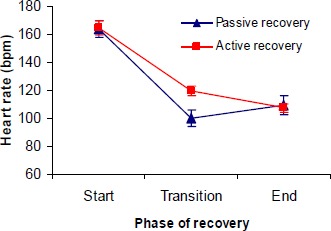
Mean heart rates for passive and active recoveries. Start is heart rate at the beginning of the recovery period. Transition indicates heart rate at the end of the two minute active/passive recovery. End refers to the heart rate at the end of the complete recovery period including refocusing phase.
Discussion
The aim of the present study was to examine the effects of short-term passive and active recoveries on lactate concentrations, RPE and heart rate response. The research was also designed to assess the impact on heart rate response of a passive refocusing phase following the active recovery phase. The refocusing or preparation phase was included to simulate the practicalities of taking part in repeat short duration high intensity exercise such as sport climbing.
In this study mean lactate concentrations were between 0.9 and 1.2 mmol·1-1 lower for the active recovery group for each of the five climbing trials. The walking based active recovery resulted in significantly lower lactate levels than the passive recovery. This finding is in agreement with research dating back over thirty years that has shown active recovery to aid the removal of lactate after short duration intensive exercise (Ahmaidi et al., 1996; Belcastro and Bonen, 1975; Corder et al., 2000; Hermansen and Stensvold, 1972; Stamford et al., 1981). In addition, the continued effectiveness of the active recovery protocol to reduce lactate concentrations for subsequent exercise trials in the present study is in agreement with the work of Ahmaidi et al. (1996) and Corder et al.(2000) Bangsbo et al. (1994) and Connolly et al. (2003), however, found no significant difference in lactate concentrations between passive and active short-term (less than or up to three minutes) recoveries.The differences in findings may relate to the active recovery strategy employed. In previous studies, such as those by Bangsbo et al., 1994 and Connolly et al., 2003, the exercise and recovery protocol have employed the same exercise medium (cycle ergometry). In rock climbing the main muscle groups responsible for producing lactate are found in the forearms and upper body (Booth et al., 1999 and Mermier et al., 1997). Therefore, in the present study, the muscle groups responsible for the net production of lactate during the short-term high intensity exercise trial (forearms and upper body) differed from those used to remove the lactate during the active walking recovery (legs). Additionally, the change in exercise medium for the recovery meant that there was an increased muscle mass involved in lactate clearance.
Understanding of the exact mechanism through which lactate is more effectively removed during active recovery continues to be refined (Corder et al., 2000; Ahmaidi et al., 1996). However, one common finding during active recovery, as found in this study, is an increased heart rate response, leading to an increased blood flow to the working muscle during the recovery interval (Ahmaidi et al., 1996; Belcastro and Bonen, 1975; Bogdanis et al., 1996). The increased blood flow is believed to enhance the removal of lactic acid from the exercising muscle cells allowing a faster redistribution to alternative metabolism sites such as the liver, heart and non-working muscles (Ahmaidi et al., 1996; Belcastro and Bonen, 1975; Bogdanis et al., 1996; Corder et al., 2000).
A significant difference between recovery protocols was found for RPE. The active recovery provided climbers with a perception of lesser effort during each subsequent climbing trial. Although when originally developed RPE was based on heart rate response during exercise it has also been found to be a conscious rating of effort and as such is perhaps a useful indicator of central fatigue) (Robergs and Roberts, 1997). Lactate concentration analysis, on the other hand, perhaps provides a mechanism for indicating physical fatigue within the peripheral muscles. Thus the results of this study indicate that active recovery appears to have a significant impact on reducing peripheral (lactate) and central fatigue (RPE).
The heart rate responses during climbing differed by three or fewer beats per minute between each of the climbing trials for passive and active recovery strategies. There were no significant differences between passive and active recovery conditions for any of the five climbing trials. This would suggest that work intensity was closely matched for both conditions. There was, however, a rise in heart rate during exercise for active and passive conditions across the five climbing trials. This finding, when taken with similar and significant rises with successive climbing trials for lactate concentrations and RPE scores, is indicative of incomplete recovery. The three and a half minutes recovery allowed following short-term high intensity exercise was not sufficient for a complete recovery between trials. This was the case for the passive and active recovery protocols and is in agreement with the findings of Ahmaidi et al., 1996 and Connolly et al., 2003. A longer recovery period would be necessary to maintain exercise responses, however, in a practical sports training or performance setting this might not be possible. As a consequence, an active recovery strategy would be the preferred method where repeat performance was required.
The use of a split (active/passive refocusing or passive/passive refocusing) phase recovery had a significant effect on the heart rate response of climbers between conditions. Although heart rate responses were significantly higher following the active phase of the recovery (after two minutes of recovery), in agreement with the findings of Ahmaidi et al., 1996 and Bogdanis et al., 1996, by the end of the refocusing period (after three and a half minutes of recovery) there was a non-significant difference between the recovery conditions. In fact, as can be seen in Table 3, by the end of the recovery for all but the first climbing trial the mean heart rates were lower for the active than for the passive recovery strategy, perhaps suggesting a more complete recovery prior to commencing the next climbing trial.
Conclusions
The results of the present study suggest there are benefits to using a short duration active recovery for both lactate clearance and RPE on subsequent exercise trials. The study appears to have created a practical strategy that could be employed by sport climbers and boulderers to possibly combat the effects of central and peripheral fatigue. For the sport of rock climbing, where the forearm muscles may represent the net producers of lactate and the lower limbs a major tissue for lactate removal, the use of a walking active recovery may be beneficial to subsequent climbing trials. The use of alternative skeletal muscle groups for lactate clearance as discussed by Van Hall and colleagues (2002) requires further investigation. In addition, future research to examine the benefits of a refocusing period following an active recovery may be useful in an applied sports context.
Biographies

Nick Draper
Employment
Senior Lecturer, Centre for Adventure Science Research (CASR), University of Chichester, UK.
Degree
Ph.D., M.A., B.Ed.(Hons)
Research interests
Adventure Physiology - physiological response to environmental and exercise demands in adventure sports.
E-mail: N.Draper@chi.ac.uk
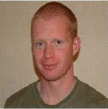
Ellis L. Bird
Employment
Postgraduate Research at CASR, University of Chichester, UK, Lecturer in Adventure Education at Southdowns College, Portsmouth, UK
Degree
B.A.(Hons)
Research interests
The physiology of rock climbing and bouldering.
E-mail: E.Bird@chi.ac.uk

Ian Coleman
Employment
Senior Lecturer, University of Chichester, UK.
Degree
B.Ed.(Hons)
Research interests
Human performance and pedagogy in kayaking and climbing.
E-mail: I.Coleman@chi.ac.uk
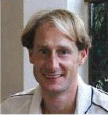
Chris Hodgson
Employment
Senior Lecturer, CASR, University of Chichester, UK.
Degree
M.Sc., B.A.(Hons)
Research interests
Senior Learning and performing in complex and challenging environments and how we can improve performance during environmentally induced stress.
E-mail: C.Hodgson@chi.ac.uk
References
- Ahlborg G., Hagenfeldt L., Wahren J. (1975) Substrate utilization by the inactive leg during one-leg or arm exercise. Journal of Applied Physiology 39, 718-723 [DOI] [PubMed] [Google Scholar]
- Ahmaidi S. Granier, P. Taoutaou Z. Mercier, J. Dubouchaud H., Prefaut C. (1996) Effects of active recovery on plasma lactate and anaerobic power following repeated intensive exercise. Medicine and Science in Sports and Exercise 28, 450-456 [DOI] [PubMed] [Google Scholar]
- Ainsworth B.E., Serfass R.C., Leon A.S. (1993) Effects of recovery duration and blood lactate level on power output during cycling. Canadian Journal of Applied Physiology 18, 19-30 [DOI] [PubMed] [Google Scholar]
- Bangsbo J., Graham T., Johansen L., Saltin B. (1994) Muscle lactate metabolism in recovery from intense exhaustive exercise: Impact of light exercise. Journal of Applied Physiology 77, 1890-1895 [DOI] [PubMed] [Google Scholar]
- Belcastro A.N., Bonen A. (1975) Lactic acid removal rates during controlled and uncontrolled recovery exercise. Journal of Applied Physiology 39, 932-936 [DOI] [PubMed] [Google Scholar]
- BMC (2004) Annual Report. British Mountaineering Council: Manchester [Google Scholar]
- Bogdanis G., Nevill M.E., Lakomy H.K.A., Graham C.M., Louis G. (1996) Effects of active recovery on power output during repeated maximal sprint cycling. European Journal of Applied Physiology 74, 461-469 [DOI] [PubMed] [Google Scholar]
- Booth J., Marino F., Hill C., Gwinn T. (1999) Energy cost of sport rock climbing in elite performers. British Journal of Sports Medicine 33, 14-18 [DOI] [PMC free article] [PubMed] [Google Scholar]
- Borg G.A.V. (1982) Psychophysical bases of perceived exertion. Medicine and Science in Sports and Exercise, 14, 377-381 [PubMed] [Google Scholar]
- Carlson L.A., Pernow B. (1959) Oxygen utilization and lactic acid formation in the legs at rest and during exercise in normal subjects and in patients with arteriosclerosis obliterans. Acta Medica Scandinavia 164, 39-52 [DOI] [PubMed] [Google Scholar]
- Connolly D.A.J., Brennan K.M., Lauzon C.D. (2003) Effects of active versus passive recovery on power output during repeated bouts of short term, high intensity exercise. Journal of Sports Science and Medicine 2, 47-51 [PMC free article] [PubMed] [Google Scholar]
- Corder K.P., Potteiger J.A., Nau K.L., Figoni S.F., Hershbereger S.L. (2000) Effects of active and passive recovery conditions on blood lactate, rating of perceived exertion and performance during resistance exercise. Journal of Strength and Conditioning Research 14, 151-156 [Google Scholar]
- Fletcher W.M., Hopkins F.G. (1907) Lactic acid in amphibian muscle. Journal of Physiology 35, 16-309 [DOI] [PMC free article] [PubMed] [Google Scholar]
- Freyschuss U., Strandell T. (1967) Limb circulation during arm and leg exercise in supine position. Journal of Applied physiology 23, 163-170 [DOI] [PubMed] [Google Scholar]
- Gollnick P.D., Pernow B., Essén B., Jansson E., Saltin B. (1981) Availability of glycogen and plasma FFA for substrate utilization in leg muscle of man during exercise. Clinical Physiology 1, 27-42 [Google Scholar]
- Hardy L., Martindale K. (1982) Some physiological parameters in rock-climbing. Physical Education Review 5, 41-44 [Google Scholar]
- Hermansen L., Stensvold I. (1972) Production and removal of lactate during exercise in man. Acta Physiologica Scandinavica 86, 191-201 [DOI] [PubMed] [Google Scholar]
- Leger L.A., Lambert J. (1982) A maximal multistage 20-m shuttle run test to predict VO2max. European Journal of Applied Physiology 49, 1-12 [DOI] [PubMed] [Google Scholar]
- Mainwood G., Renaud J. (1985) The effect of acid-base on fatigue of skeletal muscle. Canadian Journal of Physiology and Pharmacology 63, 403-416 [DOI] [PubMed] [Google Scholar]
- McLoughlin P., McCaffery N., Moynihan J.B. (1991) Gentle exercise with a previously inactive muscle group hastens the decline of blood lactate concentration after strenuous exercise. European Journal of Applied Physiology 62, 274-278 [DOI] [PubMed] [Google Scholar]
- Mermier C.M., Janot J.M., Parker D.L., Swan J.G. (2000) Physiological and anthropometric determinants of sport climbing performance. British Journal of Sports Medicine 34, 359-366 [DOI] [PMC free article] [PubMed] [Google Scholar]
- Mermier C.M., Rodbergs R.A., McMinn S.M., Heyward V.H. (1997) Energy expenditure and physiological responses during indoor rock climbing. British Journal of Sports Medicine 31, 224-228 [DOI] [PMC free article] [PubMed] [Google Scholar]
- Richter E.A., Kiens B., Saltin B., Christensen N.J., Savard G. (1988) Skeletal muscle glucose uptake during dynamic exercise in humans: Role of muscle mass. American Journal of Physiology, Endocrinology and Metabolism 254, E55-E561 [DOI] [PubMed] [Google Scholar]
- Robergs R.A., Roberts S.O. (1997) Exercise physiology, exercise, performance, and clinical applications. Moby-Year, Inc [Google Scholar]
- Rowell I., Saltin B.R., Kiens B., Christenson N.J. (1986) Is peak quadriceps blood flow in humans even higher during exercise with hypoxemia? Heart Circulation and Physiology 20, H1038-H1044 [DOI] [PubMed] [Google Scholar]
- Stamford B.A., Weltman A., Moffat R., Sady S. (1981) Exercise recovery above and below anaerobic threshold following maximal work. Journal of Applied Physiology 51, 840-844 [DOI] [PubMed] [Google Scholar]
- Van Hall G., Jensen-Urstad M., Rosdahl H., Holmberg H.-C., Saltin B., Calbet J.A.L. (2002) Leg and arm lactate and substrate kinetics during exercise. American Journal of Physiology, Endocrinology and Metabolism 284, E193-E205 [DOI] [PubMed] [Google Scholar]
- Watts P.B., Daggett M., Gallagher P., Wilkins B. (2000) Metabolic response during sport rock climbing and the effects of active versus passive recovery. International Journal of Sports Medicine 21, 185-190 [DOI] [PubMed] [Google Scholar]
- Watts P.B. Drobish K.P. (1998) Physiological responses to simulated rock climbing at different angles. Medicine and Science in Sports and Exercise 30, 1118-1122 [DOI] [PubMed] [Google Scholar]
- Watts P.B., Martin D.T., Durtschi S. (1993) Anthropometric profiles of elite male and female competitive sport rock climbers. Journal of Sports Science 11, 113-117 [DOI] [PubMed] [Google Scholar]
- Watts P., Newbury V., Sulentic J. (1996) Acute changes in handgrip strength, endurance and blood lactate with sustained sport rock climbing. Journal of Sports Medicine and Physical Fitness 36, 255-260 [PubMed] [Google Scholar]
- Weltman A., Stamford B.A., Moffatt R.J., Katch V.L. (1977) Exercise recovery, lactate removal and subsequent high intensity exercise performance. Research Quarterly, 48, 786-796 [PubMed] [Google Scholar]


